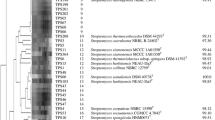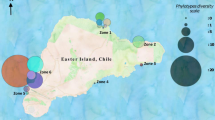Abstract
The “Cave of Crystals” (aka ‘Naica’) in Chihuahua Mexico is a natural unique subterranean ecosystem which mainly consists of crystals made of calcium sulfate. The main system of caves are found at a depth of 300 meters (m) below sea level with crystals that range in size from a few centimeters to 15 m. The crystals date from nearly 400,000 years old and are thought to be formed when the cave was fully covered by water. At present time, this place shows a nearly constant temperature of 55 °C over the year and a humidity of 100 % which makes this place incomparable and unbearable to animal and/or human life. In the present study, two actinobacterial groups were isolated from within this system of caves and subjected to a systematic study to establish their phylogenetic relationship to microorganisms belonging to this vast group of Gram positive bacteria. Phenotypic properties, chemotaxonomic and 16S rRNA gene sequencing show that the microorganisms are members of the family Pseudonocardiaceae and are most closely related to the genus Prauserella. The present study is the first to report the isolation and presence of Actinobacteria or any other microbial form of life in this exceptional place. Moreover, this unexpected biodiversity can also provide an insight of the antibiotic resistome present in the isolates reported in this study.


Similar content being viewed by others
Explore related subjects
Discover the latest articles and news from researchers in related subjects, suggested using machine learning.References
Badino G, Forti P (2007) The exploration of the caves of the Giant Crystals (Naica, Mexico) NSS News 65:12–18
Barton HA, Jurado V (2007) What’s up down there? Microbial diversity in caves. Microbe 2:132–138
Bergey’s Manual of Systematic Bacteriology (2012) Goodfellow M, Kämpfer P, Busse H-J, Trujillo ME, Suzuki K-I, Ludwig W, Whitman WB (eds) Bergey’s manual of systematic bacteriology: the actinobacteria, part A, 2nd edn, vol 5. Springer, New York
Bhullar K, Waglechner N, Pawlowski A, Koteva K, Banks ED, Johnston MD, Barton HA, Wright GD (2012) Antibiotic resistance is prevalent in an isolated cave microbiome. PLoS One 7:e34953
Bull AT (ed) (2004) Microbial diversity and bioprospecting. ASM Press, Washington DC
Chun J (2001) PHYDIT version 3.1 (available at http://plaza.snu.ac.kr/~jchun/phydit/). Accessed 31 March 2013
Chun J, Goodfellow M (1995) A phylogenetic analysis of the genus Nocardia with 16S rDNA gene sequences. Int J Bacteriol 45:240–245
Chun J, Lee JH, Jung Y, Kim M, Kim S, Kim BK, Lim YW (2007) EzTaxon: a web-based tool for the identification of prokaryotes based on 16S ribosomal RNA gene sequences. Int J Syst Evol Microbiol 57:2259–2261
D’Costa VM, McGrann KM, Hughes DW, Wright GD (2006) Sampling the antibiotic resistome. Science 311:374–377
Felsenstein J (1985) Confidence limits on phylogenies: an approach using the bootstrap. Evolution 39:783–791
Forti P, Galli E, Rossi A (2007) The mineralogical study on the cueva de las velas (Naica, Mexico). Acta Carsologica 36:379–388
Gontang EA, Fenical W, Jensen PR (2007) Phylogenetic diversity of gram positive bacteria cultured from marine sediments. Appl Environ Microbiol 73:3272–3282
Gordon RE, Mihm JM (1962) Identification of Nocardia caviae (Erikson) nov. comb. Ann NY Acad Sci USA 98:628–636
Groth I, Vetttermann R, Schuetze B, Schumann P, Saiz-Jimenez C (1999) Actinomycetes in Karstic caves of northern Spain (Altamira and Tito Bustillo). J Microbiol Methods 36:115–122
Groth I, Schumann P, Laiz L, Sánchez-Moral S, Cañaveras JC, Saiz-Jiménez C (2001) Geomicrobiological study of the Grotta dei Cervi, Porto Badisco, Italy. Geomicrobiol J 18:241–258
Jukes TH, Cantor CR (1969) Evolution of protein molecules. In: Munro HN (ed) Mammalian protein metabolism, vol 3. Academic Press, New York, pp 21–132
Laiz L, Groth I, Schumann P, Zezza F, Felske A, Hermosin B, Saiz-Jiménez C (2000) Microbiology of the stalactites from Grotta dei Cervi, Porto Badisco, Italy. Int Microbiol 3:25–30
Lane DJ (1991) 16S/23S rRNA sequencing. In: Stackebrandt E, Goodfellow M (eds) Nucleic acid techniques in bacterial systematics. Wiley, New York, pp 115–175
Lazcano SC (2001) Naica’s subterranean marvels. NSS News 59:166–169
Lee SD (2006) Amycolatopsis jejuensis sp. nov. and Amycolatopsis halotolerans sp. nov., novel actinomycetes isolated from a natural cave. Int J Syst Evol Microbiol 56:549–553
Maldonado LA, Fenical W, Jensen PR, Kauffman CA, Mincer TJ, Ward AC, Bull AT, Goodfellow M (2005a) Salinispora arenicola gen. nov., sp. nov. and Salinispora tropica sp. nov., obligate marine actinomycetes belonging to the family Micromonosporaceae. Int J Syst Evol Microbiol 55:1759–1766
Maldonado LA, Stach JEM, Pathom-aree W, Ward AC, Bull AT, Goodfellow M (2005b) Diversity of cultivable actinobacteria in geographically widespread marine sediments. Antonie Van Leeuwenhoek 87:11–18
Maldonado LA, Stach JEM, Ward AC, Bull AT, Goodfellow M (2008) Characterisation of micromonosporae from aquatic environments using molecular taxonomic methods. Antonie Van Leeuwenhoek 94:289–298
Maldonado LA, Fragoso-Yáñez D, Pérez-García A, Rosellón-Druker J, Quintana ET (2009) Actinobacterial diversity from marine sediments collected in Mexico. Antonie Van Leeuwenhoek 95:111–120
Saitou N, Nei M (1987) The neighbour-joining method: a new method for reconstructing phylogenetic trees. Mol Biol Evol 4:406–425
Seo JP, Yun Y-W, Lee SD (2007) Nocardia speluncae sp. nov., isolated from a cave. Int J Syst Evol Microbiol 57:2932–2935
Shirling EB, Gottlieb D (1966) Methods for characterization of Streptomyces species. Int J Syst Bacteriol 16:317–327
Stach JEM, Maldonado LA, Masson DG, Ward AC, Goodfellow M, Bull AT (2003) New primers for the class Actinobacteria: application to marine and terrestrial environments. Environ Microbiol 5:828–841
Stackebrandt E, Rainey FA, Ward-Rainey NL (1997) Proposal for a new hierarchic classification system, Actinobacteria classis nov. Int J Syst Bacteriol 47:479–491
Staneck JL, Roberts GD (1974) Simplified approach to identification of aerobic actinomycetes by thin-layer chromatography. Appl Microbiol 28:226–231
Van de Peer Y, DeWachter R (1994) TREECON for Windows: a software package for the construction and drawing of evolutionary trees for the Microsoft Windows environment. Comput Appl Biol Sci 10:569–570
Wang J, Li Y, Bian J, Tang S-K, Renu B, Chen M, Li W-J, Zhang L-X (2009) Prauserella marina, sp. nov., isolated from ocean sediment of the South China Sea. Int J Syst Evol Microbiol. doi:10.1099/ijs.0.013862-0
Zhi XY, Li WJ, Stackebrandt E (2009) An update of the structure and 16S rRNA gene sequence-based definition of higher ranks of the class Actinobacteria, with the proposal of two new suborders and four new families and emended descriptions of the existing higher taxa. Int J Syst Evol Microbiol 59:589–608
Acknowledgments
This work was supported entirely by grants to LA Maldonado and ET Quintana. PCR, purified products and sequencing expenses were covered with grant #612 (ICMyL, UNAM) to LA Maldonado. Expenses to cover all other reagents and tests came from ET Quintana’s Grant #57832 (Consejo Nacional de Ciencia y Tecnología, Mexico). Dr. LA Maldonado gratefully acknowledges M. C. Laura Márquez (Instituto de Biología, UNAM) for 16S rRNA gene sequences and Dr. Juan Morales-Malacara (UMDI-Juriquilla, UNAM) for providing the environmental samples.
Author information
Authors and Affiliations
Corresponding author
Additional information
Almost complete 16S rRNA gene sequences of the Cave of Crystals isolates AE-2, AE-4y-A, AE-5, AE-7, AE-11x and AE-131 have been deposited under GenBank accession numbers GU292536 to GU292541, respectively. An actinobacterial partial 16S rDNA gene sequences for isolates AE-1y, AE-4x, AE-4y-B, AE-9-A, AE-9-B and AE-10 correspond to GenBank accession numbers GU292542 to GU292547, respectively.
Rights and permissions
About this article
Cite this article
Quintana, E.T., Badillo, R.F. & Maldonado, L.A. Characterisation of the first actinobacterial group isolated from a Mexican extremophile environment. Antonie van Leeuwenhoek 104, 63–70 (2013). https://doi.org/10.1007/s10482-013-9926-0
Received:
Accepted:
Published:
Issue Date:
DOI: https://doi.org/10.1007/s10482-013-9926-0




